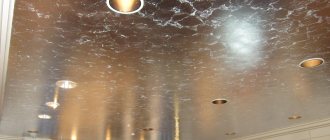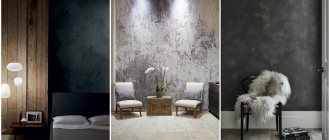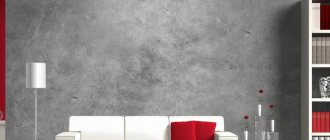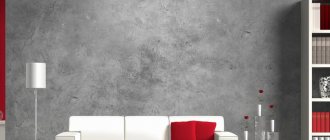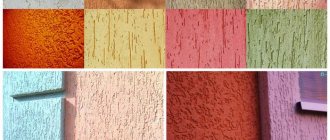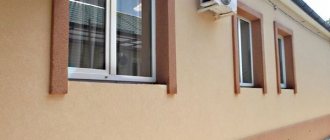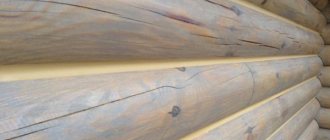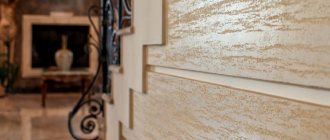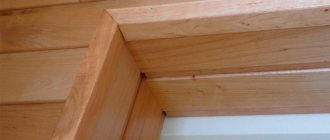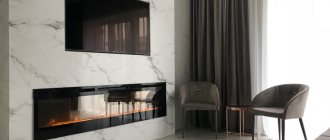Venetian plaster in the kitchen is an aesthetic, durable coating that allows you to imitate a marble surface and the texture of other stones. Depending on the components, the coating can be smooth with a glossy sheen or semi-gloss, the color range and combination options with vinyl wallpaper, gypsum moldings, and stone are different.
Venetian plaster, features
Venetian plaster will make your kitchen look luxurious.
Venetian plaster is a decorative coating for people who can appreciate a classic interior. A variety of color combinations and tints allows you to give the surface the most vibrant appearance. When using this wall decoration idea, there is the opportunity to implement many design ideas, but most people choose a marble effect for the kitchen.
This coating is made on the basis of acrylic or minerals. When used in the kitchen, Venetian plaster not only allows you to admire the noble interior, but also protects the walls from moisture.
There is an opinion that this universal material is overpriced. Venetian plaster is indeed expensive, but its total price drops significantly if a minimum number of layers are used.
Coverage classification
If the appearance of plaster is assessed, the following varieties are distinguished:
- Smooth (universal).
- Embossed.
- Artistic (the rarest).
Depending on the composition of the coating, Venetian plaster is divided into the following types:
- based on pure lime;
- a mixture of acrylate copolymer with lime;
- acrylic as a binder.
To choose the most optimal option, you must first evaluate the main types of Venetian plaster, and then select the most suitable coating from the representatives of the category you like. Typically, Venetian plaster is made from marble dust, the color and suitable consistency of which is selected using a binder.
In most cases, acrylate with lime is used. This plaster is quite easy to work with if you learn how to apply it correctly.
The walls will look elegant, a real highlight
If a lime binder is used, repair work is much more difficult for several reasons:
- It is possible to use only light shades, which is often difficult to fit into the interior of some styles, for example, Rococo or Empire.
- The color upon application is strikingly different from that which appears upon drying. This is due to the strong lightening of the shade; a difference of up to 5 tones is possible.
- It is necessary to apply plaster not only when forming an absolutely even and smooth coating, but also to control the thickness of the layer. In this case, you will have to level the walls 100%, and be careful when working.
When the plaster has transitions in the thickness of the layer, darker spots may appear on it when drying. This phenomenon is called the staining effect.
Decorative plaster in the kitchen interior
Venetian plaster differs from similar wall finishing coatings in many characteristics, among which the presence of wax in the composition is of particular importance. It not only protects the coating. When the work is ready, you will notice an unusual reflection that can be compared to a marble glow. No varnish can give the surface a similar effect. Venetian plaster should not be coated with varnish, as it can create a glossy plastic effect.
Advantages and disadvantages
Venetian plaster is most often used in classic interiors.
Venetian plaster has many advantages, which is confirmed by numerous consumer reviews.
This material is so durable and reliable that manufacturers provide a guarantee of 10 years or more.
The main advantages of Venetian plaster:
- The composition is completely environmentally friendly. During its preparation, application and use, the human body does not receive harmful substances, so this material is the best for most allergy sufferers. All components are tested for safety, since the original mixture is made from safe materials.
- If you want to cover the walls with marble, you can’t do without Venetian plaster. Only this finishing material is able to replace this durable and decorative rock in shade and durability. This plaster has an unusual internal glow, which adds chic to the interior.
- When Venetian plaster is applied to the surface when repairing kitchen walls, cracking of the finish is excluded, so when carrying out repairs you can be sure that it will not only be beautiful, but also guaranteed to be durable.
- This plaster contains wax. When a certain surface is covered with it, it becomes insensitive to the action of water, long periods of general humidity in the room, and also does not respond to temperature changes, which allows you to keep all building materials in their original condition.
- With the help of Venetian plaster, you can decorate not only absolutely smooth walls, but also surfaces with potholes and defects, but commensurate with the consistency of the prepared composition. If you decide to cover the walls with this material, there is no need to worry about small unevenness, since they can be filled to a completely smooth state.
- The Venetian plaster coating can be repaired up to the visual creation of a new repair, and it can also be restored.
This material does not have many disadvantages, but they may influence the decision to purchase Venetian plaster. The following disadvantages stand out:
- High cost of material. Venetian plaster is several times more expensive than other coatings.
- Without the appropriate skills, the coating is difficult to apply. To create a perfectly even base, you will have to practice in advance.
- The need for preliminary surface finishing. The walls may contain slight irregularities, but any cracks, clear depressions and destructive processes must be completely eliminated.
Read about finishing the kitchen with laminate at “https://ilkitchen.ru/remont/pol/pokrytie/laminat/vlagostojkij-vse-o-preimushhestvax-i-nedostatkax.html
Materials used to decorate the kitchen
Most often, paint, ceramic tiles and wallpaper are used to decorate the kitchen. So you can see what advantages and disadvantages each material has.
Paint in the kitchen
The choice of paint today is extremely large, and you can choose one that suits a variety of necessary requirements - for any external conditions and in any color. The advantages include an affordable price and the ability to wash painted surfaces.
Paint in the kitchen
The disadvantage is low mechanical resistance; scratches and impacts leave marks on the paint, which necessitates repainting after some time.
Ceramic tile
Resistant, mechanically strong material that can withstand strong temperature fluctuations and exposure to mildly aggressive environments. Available in a wide range of colors and various surface options.
Ceramic kitchen
Certain disadvantages can be considered the surface in the form of a mosaic, which over time causes contamination and destruction of the grout, as well as the coldness of the material itself.
Or maybe wallpaper?
A widespread and easily implemented type of finishing, a large selection of materials, colors and patterns. Ease of use, availability and low price (for paper wallpaper).
Wallpaper in the kitchen
Disadvantages include low mechanical strength, exposure to mildly aggressive environments, and susceptibility to contamination.
How to make it yourself
You can make Venetian plaster with your own hands, but it will require some skill
Anyone can create and apply Venetian plaster. All you need is to take all the necessary ingredients and equipment. Before carrying out the work, it is necessary to study the step-by-step technology, since only high-quality and measured application of the coating will allow you to admire ideal walls.
First you need to prepare the surface. It must be properly leveled. The basis can be any walls coated with a primer. Even if there is paint on the walls, you must first clean it of any dirt.
It is advisable that the surface under Venetian plaster contains nothing other than initial wall treatment and primer. This is the only way to guarantee the durability of the material.
You can decorate some part of the wall, thereby attracting its attention
Preparing the walls is carried out in the same way as cleaning the walls before pasting. All irregularities are sanded to form a completely smooth surface. Then the wall is completely primed.
It is necessary to choose a deep penetration primer. With its help, you can provide reliable protection of the surface from mold and mildew. Also, a high-quality primer increases the absorbency of the walls, which helps ensure stronger adhesion of the plaster to the wall. Allow the plaster to dry for 24 hours before continuing work.
The final coating with primer is organized at least within 24 hours. It helps make the walls as receptive to plastering as possible. The primer dries quickly, but you should let it sit for about a day, only then work on applying Venetian plaster begins. Do-it-yourself Venetian plaster, video with expert advice:
Imitation or what to replace
Options for plaster imitation.
Wallpaper
They perfectly imitate the Venetian style and allow you to get an equally attractive result without extra costs and complex applications.
Tension fabrics (for ceilings)
Stretch products with such an imitation are particularly beautiful and sophisticated, but they represent a rather unusual and not yet very common interior solution.
Panels
The lightweight panels are easy to install, perfectly hide unevenness in the top, and look in no way inferior to the original.
Tile
It combines well with various materials, is resistant to mechanical stress and temperature changes. The tile ideally imitates rocks such as pink or amber onyx, gray granite or dark green malachite.
How to prepare the composition
- Prepare a container for the mixture. Dry powder must be placed in it with water. The proportions are indicated on the packaging. You should use water whose temperature is above 10 degrees.
- To mix the mixture, you must use a construction mixer. An alternative is a drill with an appropriate attachment. The solution should be stirred until it resembles the consistency of sour cream.
- It’s worth letting the composition sit. Then it is thoroughly mixed again. At the same time, its homogeneity is checked.
- The final and most crucial moment is adding dye to the mixture. It is necessary to add it in an amount that is optimal for a particular interior.
Kitchen safety rules, here.
Application technology
Venetian plaster will make even an ordinary kitchen amazing
It is advisable to apply only fresh material, that is, try to prepare as much plaster as the master can use at one time. The solution is prepared from pure ingredients. Purified drinking water and powder with an optimal shelf life are used. You can make your walls beautiful only with the use of high-quality mortar.
Each layer is applied to the kitchen walls according to a specific pattern:
- the work is done with a large spatula;
- the mixture is located on the surface from the top side, usually from the left corner;
- the edges are rounded and ground. Any defects should be excluded, including burrs and scratches;
- a sufficient amount of plaster is taken onto a spatula to subsequently cover a large space with it;
- While working with a spatula, you can make any movements. When working, it is allowed to change the direction of movement to achieve an ideal surface;
- After initial application, sand the surface immediately. A spatula is used for this. It needs to be pressed firmly into the wall, as if smoothing out a layer of plaster. These steps are repeated until the most even and thin layer is achieved;
- After 2-3 movements with the spatula, it is necessary to clean the spatula from the composition using a cloth soaked in water. Next to the already sanded layer, you need to apply the next one. Care should be taken to disguise the transition. These actions are carried out until the entire wall is painted.
When working with Venetian plaster, many novice craftsmen are perplexed about its rapid drying. You will have to come to terms with this property and learn to perform the necessary actions not only efficiently, but also at an accelerated pace.
All about the advantages and disadvantages of Venetian plaster for the kitchen:
Work is only allowed at temperatures above 5 degrees. This parameter must be specified on the packaging of the product. The higher the temperature, the faster the Venetian plaster dries. If you perform work at a room temperature of more than 20 degrees, you can expect the layer to dry completely within an hour. When the temperature is higher, the drying process speeds up.
Each layer of Venetian plaster is placed according to a specific pattern, which involves several actions:
- initial application of material to the surface;
- layer leveling;
- grinding;
- polishing, giving the surface a glossy sheen (for the final layer).
Venetian plaster will be the highlight of your kitchen
All stages of work are carried out in an accelerated mode, since with delay the plaster dries out and becomes more viscous, which makes it impossible to give it an optimal shape and thoroughly level the surface. If the kitchen is large, it is advisable to organize joint work with 2-3 partners. More competent people will be able to give the coating smooth contours, and inexperienced people will be able to carry out the initial application of the material. This method helps to make the coating high quality.
The walls will resemble noble marble
Before applying each subsequent layer, excess protrusions and other protruding defects are removed from the previous one using fine sandpaper. This element should be handled carefully so as not to damage the coating. The final layer is done differently from the previous ones, because it is the face of the decorative finish.
To give the surface a marble pattern, you will have to work separately with a spatula. Usually the medium size of this device is chosen, but some people prefer to work on the design for a long time with a small spatula.
Once the lines resembling marble tints have been applied, the coating should be thoroughly polished. With the help of polishing, experienced craftsmen achieve a variety of effects, which are determined depending on the surrounding interior. Usually a glossy or matte effect is chosen for the kitchen, but some prefer the brightest and most shiny walls.
Everything you need to know about Venetian plaster:
Protective covering
After applying all layers of Venetian plaster, the walls should be protected from negative influences and any construction work with a new coating should be limited for a period of about 5 days. After this time, it is necessary to cover the walls with a protective solution containing wax. To apply it, you can use a cotton napkin, but professionals use a trowel.
The sophistication and elegance of Venetian plaster imparts a certain character to the entire room.
The wax is applied with gentle movements, preferably in a circular direction. An absolutely even layer is achieved, since with a contrast in the thickness of the layer, dark spots may appear in areas more saturated with the product.
Usually there is a need to treat Venetian plaster in two layers. You can wash the walls for the first time after this procedure for 3-5 days. This information is specified on the packaging of a specific product.
How to create a wall with imitation marble in our video:
What color is the Venetian?
The most popular colors.
White
Allows you to enhance, highlight and highlight other shades and decorative items in the interior. Using white, white-gray or ivory, you can create a perfect and fresh design.
The photo shows a wall decorated with white-gray Venetian plaster.
Blue
It will bring special sophistication and sophistication to the atmosphere and create a relaxing and calm interior.
Grey
The elegant and unique gray shade is very practical. It will undoubtedly add a certain aristocracy to the room.
Black
Creates rich, bold and contrasting accents in the interior. A room decorated in black will look modern and noble, and will acquire a more expressive and clear appearance.
Green
Evokes associations with warmth, summer and fresh greenery. This color creates a comfortable environment and makes it interesting, unusual and very colorful.
Turquoise
It has special brightness and saturation. Turquoise color radically transforms the room and undoubtedly becomes its main accent.
Beige
Classic light beige shades in the interior look restrained, calm and elegant. Thanks to their neutrality, it is possible to create an unobtrusive design and visually expand the space.
Blue
Incredibly delicate and sophisticated blue color creates a soulful and soft atmosphere.
The photo shows a children's room and walls with mother-of-pearl Venetian coating in blue.
Silver
Fills the room with mystery and lunar twinkle. Silver shades, thanks to alluring tints, create bold, shiny accents in the room.
Useful tips
- To make the process of applying Venetian plaster easy and quick, you can practice the technology on a training surface. To do this, prepare a small amount of solution, take a sheet of cardboard or other unnecessary material and apply the coating in an even layer, following all the rules.
- If there is a risk of not having time to use the entire solution, it is necessary to prepare it in small doses. The more economically the composition is used, the more economically the work on finishing the kitchen walls is carried out.
- After Venetian plaster has dried, small irregularities are often noticed. They should be immediately sanded or removed with a spatula.
- To make the marbling effect more realistic, each layer should be mixed with slightly changed color parameters. To do this, the mixture is made either darker or lightened.
Types of decorative coatings
The main types of Venetian coating.
Natural (classic)
This variety is applied using the traditional multi-layer method. Classic Venetian plaster contains marble chips, binders and various additives that provide good strength properties.
The photo shows a modern living room with classic gray plaster on the wall.
Imitation or what to replace
Plaster imitation options.
Wallpaper
Venetian plaster in the interior
the color of the plaster depends on the dye, but light shades are most often chosen
Venetian plaster is appropriate in any classical or laconic style. If you adapt the surrounding interior to it, the design in the Empire, Baroque, and Rococo styles will look harmonious. When plaster with reflective particles is used, you can adapt it to the Art Deco style and similar trends.
This material is universal. If there is a desire and imagination, it can be adapted to any stylish solution, including for a kitchen in a high-tech or loft style, where ergonomics are primarily valued, which is fully ensured by homogeneous or marble Venetian plaster.
The more modern and practical the style, the lighter the plaster is chosen. It is also advisable to use only matte tones of this coating.
Photos of 30 more great ideas!
A catalog of excellent examples of the use of plaster - a consensus of interior design with artistic solutions.
Warm colors
Exquisite Design
Corridor
Vintage style
Combination with white
Dining room
Modern style
Loft style
Large bedroom
entrance to the house
Gray and blue tones
Summer design
Open space
Greek motifs
For the beloved
Royal style
Design project
Bath
When hit by light
With a bison pattern
Rest zone
With lamps
Lampshaded
Next to the painting
Fireplace
Combination with laminate
Pink color
Bright and airy room
A color scheme
Classic style
Wall care
Venetian plaster is unpretentious to environmental factors, so it does not require special actions when caring for it.
- To clean it from dirt, just wipe the surface with a damp cloth;
- if the stain is too strong, you can use detergents that are used for furniture or other similar surfaces;
- the only restriction is the prohibition on the use of abrasive products, as they can destroy the coating.
To apply Venetian plaster, you will have to do difficult work, show care and speed at all its stages. These efforts are justified, since the style and special color of this coating cannot be compared with any similar material. Venetian plaster is easy to maintain and harmless to health, which makes its use in the kitchen not only aesthetically pleasing, but also safe. We also recommend that you read our article which will tell you how to choose washable wallpaper.
Advantages and disadvantages
When using a type of finish, it is recommended to consider the pros and cons.
Putty has the following advantages:
- wide palette of shades and textures of materials;
- the ability to reproduce natural materials;
- correction of unevenness on walls;
- resistance to humidity, temperature changes;
- durability (shelf life up to 20 years);
- resistance to mechanical damage and chemicals;
- fire safety;
- environmental friendliness of the composition;
- seamless application, no joints;
- versatility in application;
- easy care of the coating;
- ease of application;
- availability of different application techniques and design options;
- the opportunity to create an original room design.
The list of material shortcomings:
- high price of plaster with natural stone chips and other original components;
- inelasticity of the coating, the possibility of cracks;
- It takes more time than standard to decorate with Venetian plaster;
- difficult dismantling;
- water permeability of some types of material.
